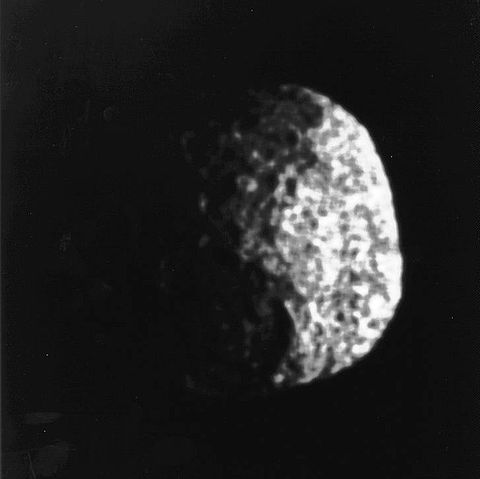 |
This is a file from the Wikimedia Commons. Information from its description page there is shown below.
Commons is a freely licensed media file repository. You can help.
|
| Description |
This image of Neptune's satellite 1989N1 was obtained on Aug. 25, 1989 from a range of 146,000 kilometers (91,000 miles) by Voyager 2. The resolution is about 2.7 kilometers (1.7 miles) per line pair. The satellite, seen here about half-illuminated, has an average radius of some 200 kilometers (120 miles). It is dark (albedo 6 percent) and spectrally grey. Hints of crater-like forms and groove-like lineations can be discerned. The apparent graininess of the image is caused by the short exposure necessary to avoid significant smear. The Voyager Mission is conducted by JPL for NASA's Office of Space Science and Applications. |
| Date |
25 August 1989 |
| Source |
http://nssdc.gsfc.nasa.gov/image/planetary/neptune/1989n1.jpg |
| Author |
NASA/JPL |
Permission
( Reusing this file) |
| Public domainPublic domainfalsefalse |
 |
This file is in the public domain because it was solely created by NASA. NASA copyright policy states that "NASA material is not protected by copyright unless noted". (See Template:PD-USGov, NASA copyright policy page or JPL Image Use Policy.) |
|
|
|
Warnings:
- Use of NASA logos, insignia and emblems are restricted per US law 14 CFR 1221.
- The NASA website hosts a large number of images from the Soviet/ Russian space agency, and other non-American space agencies. These are not necessarily in the public domain.
- Materials based on Hubble Space Telescope data may be copyrighted if they are not explicitly produced by the STScI. See also {{ PD-Hubble}} and {{ Cc-Hubble}}.
- The SOHO (ESA & NASA) joint project implies that all materials created by its probe are copyrighted and require permission for commercial non-educational use.
- Images featured on the Astronomy Picture of the Day (APOD) web site may be copyrighted.
|
|
File usage
The following pages on Schools Wikipedia link to this image (list may be incomplete):
This selection has made Wikipedia available to all children. In 133 nations around the world, SOS Children works to bring better education and healthcare to families in desperate need of support. Why not try to learn more about child sponsorship?





